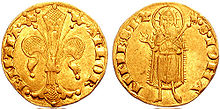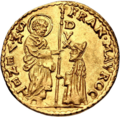Florin


The Florentine florin was a gold coin (in Italian Fiorino d'oro) struck from 1252 to 1533 with no significant change in its design or metal content standard during that time.[1] It had 54 grains (3.499 grams, 0.1125 troy ounces) of nominally pure or 'fine' gold[2] with a purchasing power difficult to estimate (and variable) but ranging according to social grouping and perspective from approximately 140 to 1,000 modern US dollars. The name of the coin comes from the Giglio bottonato (it), the floral emblem of the city, which is represented at the head of the coin.[3]
History
[edit]The fiorino d'oro (gold florin) was used in the Republic of Florence and was the first European gold coin struck in sufficient quantities since the 7th century to play a significant commercial role. The florin was recognised across large parts of Europe. The territorial usage of the lira and the florin often overlapped; where the lira was used for smaller transactions (wages, food purchases), the florin was for larger transactions such as those used in dowries, international trade or for tax-related matters.[4]
The first minting of the florin occurred in 1252. At the time the value of the florin was equal to the lira, but by 1500 the florin had appreciated; seven lire amounted to one florin.[4]
In the 14th century, about a 150 European states and local coin-issuing authorities made their own copies of the florin. The most important of these was the Hungarian forint, because the Kingdom of Hungary was a major source of European gold (until mining in the New World began to contribute to the supply in the 16th and 17th centuries, most of the gold used in Europe came from Africa).[citation needed]
The design of the original Florentine florins was the distinctive fleur-de-lis badge of the city on one side and on the other a standing and facing figure of St. John the Baptist[5] wearing a cilice. On other countries' florins, the inscriptions were changed (from "Florentia" around the fleur, and the name of the saint on the other), and local heraldic devices were substituted for the fleur-de-lis. Later, other figures were often substituted for St. John. On the Hungarian forints, St. John was re-labelled St. Ladislaus, an early Christian king and patron saint of Hungary, and a battle axe substituted for the original's sceptre. Gradually the image became more regal looking.[citation needed]
Other coins
[edit]

The term florin was borrowed elsewhere in Europe. A variant of the florin was the Rheingulden, minted by several German states encompassing the commercial centers of the Rhein (Rhine) River valley, under a series of monetary conventions starting in 1354, initially at a standard practically identical to the Florentine florin (98% gold, 3.54 grams). By 1419, the weight had been slightly reduced (to 3.51 grams) and the alloy was substantially reduced (to 79% gold). By 1626, the alloy had been slightly reduced again (to 77% gold), while the weight was more substantially reduced (to 3.240 grams). In 1409, the Rheingulden standard (at the time 91.7% gold) was adopted for the Holy Roman Empire's Reichsgulden.[6]
The Dutch guilder is symbolized as Fl. or ƒ, which means florijn (florin).
The English coin first issued in 1344 by Edward III of England is also known as a florin. Originally valued at six shillings, it was composed of 108 grains (6.99828 grams) of gold with a purity of 23 carats and 3+1⁄2 grains (or 23+7⁄8 carats)[7][8] – and more recently (minted between 1849-1967 although circulating alongside the decimal ten pence coin until 1993 when it was withdrawn due to a resizing) relating to a British pre-decimal silver coin (later nickel silver) also known as a two shilling (or two bob) "bit" (abbreviation 2/-) worth 24 pence or one-tenth of a pound.
In Ireland, a silver florin coin (worth one-tenth of an Irish pound, with Irish inscription flóirín) was minted between 1928 and 1943; it became cupronickel in 1943 and was withdrawn from use on 1 June 1994.[9]
The Hungarian forint is named after the florin.[10]
See also
[edit]- Denaro (coin)
- Florin (Australian coin)
- History of coins in Italy
- Soldo
- Venetian ducat
- Venetian grosso
- Venetian lira
References
[edit]- ^ See the Ricordanze di S. Maria di Cafaggio, which mentions florins being used in the year MCCL (1250).
- ^ Bernocchi, Mario (1976). Le monete della repubblica fiorentina. Vol. III. Leo S. Olschki Editore. p. 66.
- ^ Bazzicchi, Oreste (2011). Il paradosso francescano tra povertà e società di mercato. Effatà Editrice. p. 98. ISBN 978-88-7402-665-4.
- ^ a b Hollingsworth, Mary (2017). "A Note to the Reader". The Medici. Head of Zeus. ISBN 978-1-78669-151-4.
- ^ Horner, Susan; Horner, Joanna B. (1884). Walks in Florence and Its Environs. Vol. 2. Smith. p. 125.
- ^ W. A. Shaw (1967) [1896]. The History of Currency 1252–1894 (reprint of second ed.). New York: Augustus Kelley. LCCN 67020086.
- ^ John S. Dye (1883). Dye's coin encyclopædia: a complete illustrated history of the coins of the world ... Bradley & company. p. 761. Retrieved 22 February 2012.
- ^ Palgrave, Sir Robert Harry Inglis (1912). Dictionary of political economy. Macmillan and Co. p. 82. Retrieved 22 February 2012.
- ^ Coinage (Calling In) Order 1993 (S.I. No. 270 of 1993). Signed on 16 September 1993 by Bertie Ahern, Minister for Finance. Statutory Instrument of the Government of Ireland. Retrieved from Irish Statute Book.
- ^ Engel, Pál (2001). The realm of St. Stephen : a history of medieval Hungary, 895-1526. London: I.B. Tauris. ISBN 1-4175-4080-X. OCLC 56676014.
Bibliography
[edit]- "Ian Cnulle's Florin". Society for Creative Anachronism Archive. Archived from the original on 11 August 2017. Retrieved 11 March 2023.
- Philip Grierson (1991). Coins of Medieval Europe. Seaby, London. ISBN 1-85264-058-8.
- Peter Spufford (1988). Money and its use in medieval Europe. Cambridge University Press. ISBN 0-521-37590-8.
- Peter Spufford (1986). Handbook of Medieval Exchange. Royal Historical Society, London. ISBN 0-86193-105-X.
- Richard A. Goldthwaite, The Economy of Renaissance Florence [1]
External links
[edit]- Money museum:Fiorino d'Oro
- History of the British Florin Archived 2013-05-24 at the Wayback Machine

